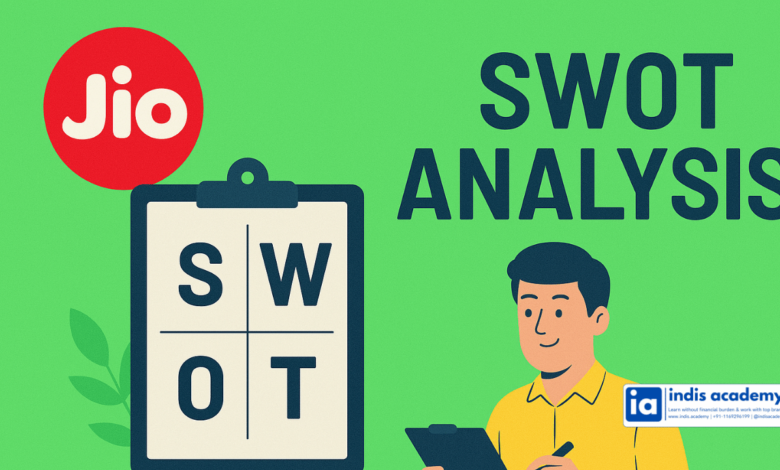Complete SWOT Analysis of Jio – A Deep Dive into India’s Telecom Disruptor

In 2016, a single launch turned India’s telecom industry upside down—Reliance Jio entered the market with free voice calls and ultra-cheap data, forever changing how Indians connect, consume, and communicate. Within just a few months, Jio transformed from an ambitious newcomer to a digital powerhouse, forcing rivals to slash prices, merge, or exit altogether.
Today, Jio is more than just a telecom operator. It’s the backbone of India’s digital ecosystem—powering everything from 4G and 5G networks to smartphones, OTT content, cloud services, and even online retail. But how does a brand grow at such scale, and what challenges lie ahead?
In this article, we’ll conduct a complete SWOT analysis of Jio, diving deep into the Strengths, Weaknesses, Opportunities, and Threats shaping one of the most disruptive companies in India’s business landscape. Whether you’re a student, entrepreneur, marketer, or tech enthusiast, this breakdown will help you understand what makes Jio a true market game-changer.
Learn AI & Digital Marketing,
Pay Fees After Placement
- ✅ Minimal Admission Fees
- ✅ No Loan or Income Sharing Agreement
- ✅ 100% Placement Support
- ✅ ISO & Govt Registered Certificate
- ✅ Practical 3+1 Months Duration
Get a free counseling call. We’ll guide you through learning, certification, and job placement.
Request a Free Call Back
Takes less than a minute.
Company Overview – About Jio
Reliance Jio Infocomm Limited, a subsidiary of Reliance Industries, was launched in 2016 with a bold vision: to make digital connectivity affordable and accessible to every Indian. Within months of its launch, Jio had already rewritten the rules of India’s telecom game.
It started by offering free voice calls and extremely low-cost 4G data, attracting millions of users overnight. Today, Jio is more than a telecom provider—it’s a digital ecosystem, offering services like:
- JioFiber (high-speed broadband)
- JioCinema & JioSaavn (entertainment & music)
- JioMart (e-commerce)
- JioMeet & JioChat (communication tools)
- JioCloud (cloud services)
As of 2024, Jio has over 450 million subscribers, making it the largest telecom operator in India and one of the top globally in terms of data usage.
With its aggressive pricing, pan-India 4G/5G infrastructure, and integration with other Reliance businesses, Jio is at the heart of India’s digital transformation journey.
Jio vs Competitors – Snapshot
| Company | Subscribers (approx.) | Key Services Offered | Market Position |
|---|---|---|---|
| Jio | 450+ million | 4G/5G, broadband, OTT, cloud, retail | Market leader |
| Airtel | 375+ million | 4G/5G, DTH, Airtel Black, Wynk, Xstream | Closest competitor |
| Vi (Vodafone Idea) | 220+ million | 4G, limited 5G rollout, OTT bundling | Struggling financially |
| BSNL/MTNL | <100 million | Primarily 3G/4G, government-backed | Minimal private market share |
Jio’s Strengths
Reliance Jio didn’t just enter the market — it redefined the telecom industry in India. Backed by strategy, innovation, and scale, Jio’s strengths form the foundation of its rapid success and market dominance.
💰 1. Backed by Reliance Industries
Jio benefits from the financial muscle and operational scale of its parent company, Reliance Industries, one of India’s most valuable conglomerates. This gives it access to massive capital for network expansion, R&D, and strategic acquisitions.
📶 2. Disruptive Pricing Model
Jio’s launch with free voice calls and ultra-low data pricing forced competitors to cut rates and merge. It created a price revolution that made mobile internet affordable for the masses—driving exponential user adoption.
🌐 3. Pan-India 4G/5G Infrastructure
Jio is the only telecom operator in India with an all-IP network from day one. Its pan-India 4G and now growing 5G infrastructure ensure faster speeds, better call quality, and lower latency.
👥 4. Massive Subscriber Base
With 450+ million active users, Jio is the largest telecom operator in India by user count, making it a data and digital services powerhouse.
🔄 5. Integrated Digital Ecosystem
Jio is more than a telco — it operates across entertainment (JioCinema, JioSaavn), e-commerce (JioMart), video conferencing (JioMeet), payments (JioPay), and cloud storage (JioCloud)—building a complete digital lifestyle for users.
🧠 6. Tech-First Approach & Innovation
Jio invests in AI, cloud, IoT, and 5G technologies. With acquisitions and strategic collaborations (e.g., with Google and Facebook), it continues to build future-ready platforms.
Jio’s Weaknesses
While Jio’s rise has been nothing short of revolutionary, it still faces a number of internal challenges that could affect its long-term sustainability and profitability.
💸 1. High Capital Expenditure & Debt Dependency
Building a nationwide 4G/5G network, laying fiber, and developing digital platforms demands huge upfront investments. Despite strong funding, Jio’s high capital expenditure and debt levels remain areas of concern for financial analysts.
🧑💻 2. Customer Service & Network Complaints
Jio has often been criticized for inconsistent customer support and network quality in high-density urban zones. Long wait times, unresolved complaints, and sudden signal drops affect user experience and satisfaction.
📉 3. Low ARPU (Average Revenue Per User)
Despite a large user base, Jio’s ARPU (around ₹170–₹180) is lower than competitors like Airtel. This affects profit margins and pressures the brand to explore new monetization models.
📦 4. Overdependence on Data Services
Voice calls are now mostly free, and Jio’s core business relies heavily on data consumption. Without diversified revenue streams (e.g., B2B services, premium apps), this could be risky as user growth slows.
🌍 5. Limited International Presence
Jio’s dominance is India-centric, with no major operations or brand recognition globally—unlike telecom giants like Vodafone, T-Mobile, or China Mobile.
Jio’s Opportunities
India’s digital economy is growing at lightning speed — and Jio sits at the center of this transformation. Here are the key opportunities that can help Jio scale even further in the coming years:
📶 1. 5G Rollout & Premium Services
Jio’s aggressive push into 5G technology opens doors for premium services like cloud gaming, smart city solutions, IoT-based applications, and ultra-low latency enterprise services. Early dominance in this space can unlock new revenue streams.
🧠 2. Expansion into Cloud & Enterprise Solutions
With rising digital transformation among Indian businesses, Jio can build JioCloud, JioMeet, and JioSecure into robust B2B solutions to compete with AWS, Google Cloud, and Microsoft Azure—especially for SMEs and government sectors.
📱 3. Rural Market Penetration via JioPhone & JioBharat
India’s rural internet usage is still underpenetrated. Jio’s low-cost smartphones and feature phones, bundled with data plans, can help bridge the digital divide and capture millions of new users.
🎬 4. OTT & Content Ecosystem Expansion
With JioCinema hosting exclusive IPL streaming and Bollywood content, Jio has a chance to become a serious competitor to Netflix, Prime Video, and Hotstar by expanding its original content and freemium models.
🤝 5. Strategic Partnerships & Acquisitions
Jio’s tie-ups with Google, Meta (Facebook), Microsoft, Qualcomm, and Intel position it to co-create apps, AI tools, cloud solutions, and future-ready devices tailored for the Indian market.
By leveraging these opportunities, Jio can transition from a telecom company to a full-fledged tech and platform giant—leading India’s digital future.
Jio’s Threats
Despite its dominant position, Jio operates in a fast-evolving and high-stakes environment. Here are the key external threats that could disrupt its growth or weaken its market hold:
⚔️ 1. Aggressive Competition from Airtel & Vi
Airtel has made a strong comeback with its 5G rollout, bundled services (Airtel Black), and higher ARPU, posing a real threat to Jio’s leadership. Vodafone Idea, despite its struggles, may also regain ground with strategic funding or partnerships.
⚖️ 2. Regulatory & Policy Risks
Jio’s scale invites greater scrutiny from telecom regulators. Any changes in spectrum pricing, TRAI rulings, or data privacy regulations could increase operational complexity and costs.
🌍 3. Rapid Technological Change
While Jio leads in 5G, emerging technologies like satellite internet (Starlink, Amazon Kuiper), AI-based telecom optimization, or mesh networks could shift the landscape quickly, demanding constant innovation.
💰 4. Price Wars & Profitability Pressure
The Indian telecom market remains price-sensitive. Prolonged price wars, discounting, and high user acquisition costs can continue to suppress margins, especially as ARPU stagnates.
🔐 5. Cybersecurity & Data Privacy Concerns
With millions of users across digital services (JioCinema, JioPay, JioCloud), Jio is a prime target for cyberattacks. A single data breach or privacy scandal could cause massive trust issues and invite legal challenges.
To stay on top, Jio must continue to innovate, diversify, and adapt to shifting technologies and regulatory frameworks — while protecting the massive digital empire it has built.
How Jio Disrupted & Redefined the Telecom Industry
When Reliance Jio entered the telecom space in 2016, it didn’t just compete — it obliterated the old model. With free calls, dirt-cheap data, and seamless onboarding, Jio transformed the way Indians used the internet, making data as basic a utility as electricity.
Within a year:
- Data costs in India dropped by over 90%
- Competitors like Aircel, Telenor, and RCom exited or merged
- India became the world’s top data consumer per user
- Millions of first-time users — especially in rural areas — came online via JioPhone
Jio’s move was not just about telecom. It was about building an entire digital ecosystem — with content, commerce, cloud, devices, and payments bundled into one seamless experience.
It redefined telecom as tech infrastructure, where connectivity powers everything — from binge-watching cricket on JioCinema to shopping on JioMart or video calling on JioMeet.
With its aggressive pricing, massive infrastructure, and deep integrations, Jio has not only disrupted telecom but reshaped India’s digital economy — and set the blueprint for what a truly digital-first company in India can look like.
Conclusion & Final Thoughts
From free data to 5G, Jio has rewritten the rules of India’s telecom and digital services industry. In less than a decade, it has gone from a disruptive newcomer to a digital ecosystem giant—powering smartphones, broadband, entertainment, cloud, commerce, and more.
This SWOT analysis of Jio shows a brand built on immense strengths like financial backing, innovation, and scale. While it still faces internal weaknesses like low ARPU and customer service gaps, the opportunities in 5G, rural expansion, and digital platforms are massive. But so are the threats—from regulatory scrutiny to aggressive rivals like Airtel and global players eyeing India’s digital future.
Jio’s journey is far from over. As India moves into a 5G-first, AI-driven digital economy, Jio has the chance to not just lead — but to become India’s first true global tech player.
What do you think about Jio’s future?
💬 Will Jio dominate India’s digital ecosystem in the next decade — or will it face new disruptors? Share your thoughts below!





